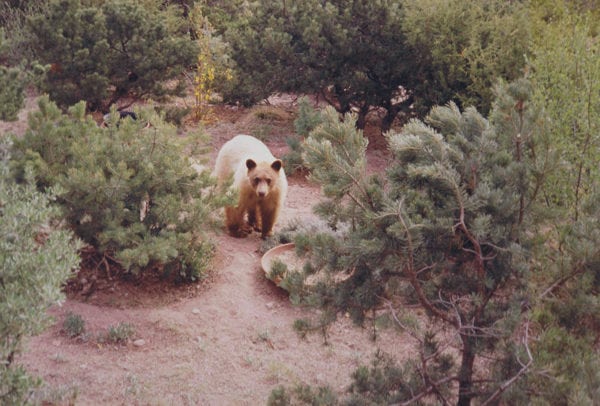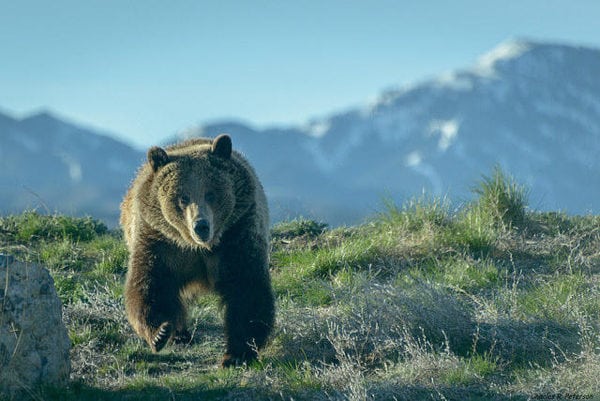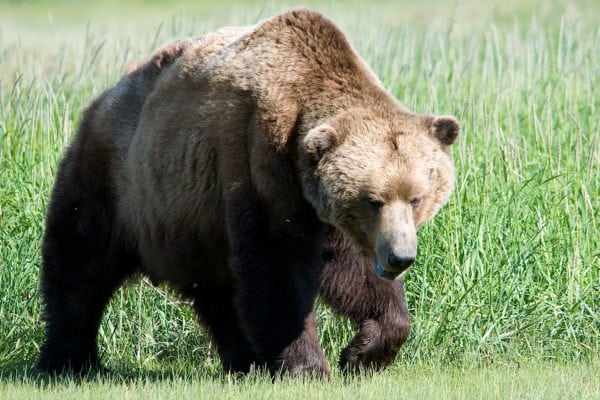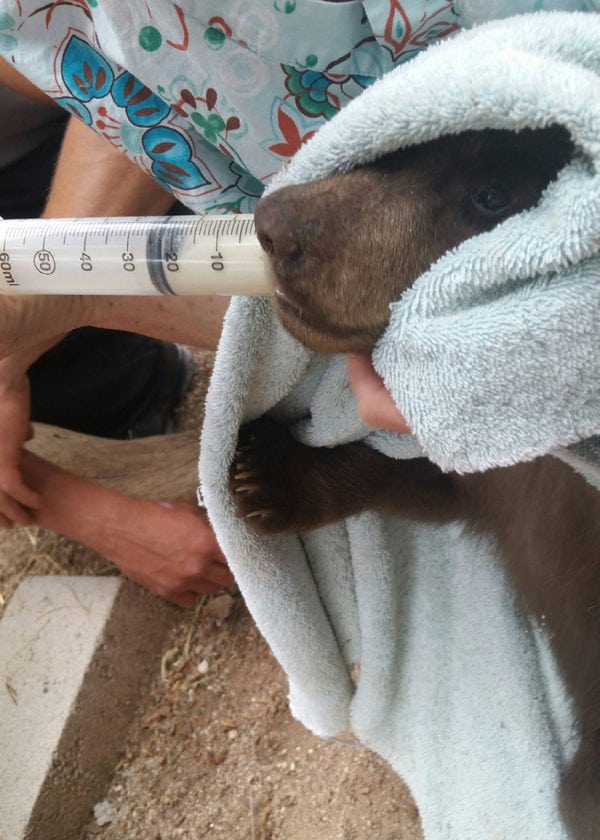You’re three miles from the finish line at the Valles Caldera Trail Marathon in the Valles Caldera National Preserve of New Mexico. Soon you’ll be able to sit down with friends and a cold beverage. Your run has gone to plan and you feel pretty good. You’re close to the back of the pack, but you won’t be last today.
You run up a short incline, crest a hill, and… come face to face with an American black bear.

An American black bear north of Santa Fe, New Mexico. You’ll notice its fur isn’t black. Sometimes American black bears, the common name for the Ursus americanus bear species, have black fur, sometimes brown, and sometimes they’re cinnamon-colored. This is not particularly helpful when you’re trying to determine whether you’re facing a black bear or brown bear. A brown bear is the common name for Ursus arctos, of which the grizzly bear is a subspecies, Ursus arctos horriblis. And that identification helps decide whether a runner should play dead or fight back if the bear attacks. More on that soon. Photo: Alton Packard
The bear is 15 feet away.
Your first thought is?
Pretty bear!
No? You’re sure that wouldn’t be your first thought after inadvertently surprising a bear? Well, that was Karen Williams’s initial thought on June 18, 2016 when this scenario played out. She remembers it distinctly. “It was a pretty bear.”
Almost simultaneously, a second thought assailed her: I’m supposed to do something!
Then she saw a cub and the mama bear charged.

A grizzly bear charging. Photo: Charles Peterson
Karen’s third thought: Put your hands over your head and make yourself big! Yell ‘NO!!!’
It didn’t work. “Then I was on my ass and being raked with claws and bitten.”
Thought four: This is going to hurt.
“I cried out in pain and mama bear did not like that so she hit me with a left hook and bit my neck and started to try to shake me. I rolled into a ball and played dead. She went off about 25 to 30 feet and stopped at the base of a tree and huffed at her cub that was up about 30 feet. The cub cried a bit while trying to get down the tree. Mama bear kept glancing my way to make sure that I was still ‘dead.’”
Karen stayed absolutely still for another 10 minutes before checking to see that the bears were gone. It was another 23 minutes after that before another runner came up the trail. (She stopped her Garmin.) The two closest aid stations were alerted, and soon, thanks to the efforts of other runners, race volunteers, and the volunteer fire department, Karen was en route to the University of New Mexico Hospital in Albuquerque.
Subsequent events occurred in rapid-fire succession. Officers from the New Mexico Department of Game and Fish (NMDGF) located and euthanized the bear in order to test it for rabies as required by New Mexico state law. Rabies is rare in bears, but nearly 100% fatal. Karen posted her story and a picture of her injuries on Facebook as an explanation and apology to the runners behind her. She was under the misimpression they’d been forced to stop after the attack, and she felt horrible about ruining their races. (That wouldn’t be your first post-mauling consideration? Mine neither.) It turned out the other runners had dropped earlier, but the post also served to thank all the trail runners who had helped her.
“Hi guys, I was the person who got into the tussle with the bear. I will tell you the whole story but first I want to thank a lot of people. The running community is amazing!”
Karen’s post was quickly shared and re-shared. Soon national and international media picked up the story. And then the outrage over the mother bear’s death began. Karen empathized with the hundreds and hundreds of angry comments about the bear’s death and the two orphaned cubs that hadn’t yet been found. She wrote: “I am really sorry the mama bear died. She was just being a bear.”
But there were also hundreds of vitriolic comments that were directed at Karen herself and that went something like this:
- “She was responsible for the bear’s death.”
- “She was invading its home.”
- “Her selfish desire to run in a nature preserve meant two bear cubs might die of starvation.”
- “Trail racing in an area known for abundant wildlife was an accident waiting to happen.”
- “Irresponsible and ignorant trail racers should be banned.”
And on and on.
“That was stressful.”
When I asked Karen, a military veteran and emergency-room and intensive-care-unit nurse, how the bear attack had changed her thoughts about nature, she said it hadn’t. “It changed my thoughts about humans.” Human aggression on social media seems like it may have affected her more deeply than the bear’s aggression.
Karen’s response to both the trauma of the attack and the vitriol afterward is unique and noteworthy. She’s spearheading a campaign to change the New Mexico law that mandates killing wild animals that attack and bite humans to test for rabies. She argues rabies is rare in bears and that the law should differentiate between bear attacks that are predatory, which is very rare for American black bears, and attacks that are defensive, as she argues hers was. There was no reason to suspect that bear had rabies. She was acting exactly as you’d expect a sow surprised at close range with cubs to act, according to Dr. Diana Doan-Crider, adjunct faculty at Texas A&M University and the Mexican Black Bear Expert Chair of the Bear Specialist Group of the International Union for the Conservation of Nature. Dr. Doan-Crider also serves on the group’s Human-Bear Conflict Team and spoke with Karen after the attack. She says this kind of attack (female black bears protecting their cubs) is well-documented behavior.
Karen expects the process she initiated to change New Mexico law, which started on July 14 at a meeting of New Mexico’s Water and Natural Resources Committee, to be long and drawn out. But she also expects to succeed. “I’ve run ultras. I can outlast any of them.”
In addition to the social-media maelstrom, Karen has also endured a lot of Monday-morning-quarterbacking since the attack (by people who have not been attacked by bears:)
- “You should have…”
- “It would have gone better for you if you had just…”
- “I would have…”
It’s always tempting to indulge in talk about bear protocols from the comfort of your bear-free house. It’s quite another to enact these protocols. (Raise your hand if you’ve been in the position of a multi-hundred-pound ball of ursine power barreling at you at more than 30 miles per hour and having only a second or two to react.) Any criticism of Karen’s actions needs to be grounded in this reality.
Karen’s attack during a popular trail race draws attention to the fact that trail runners need to know what to do if they encounter a bear. They also need to know how to avoid those encounters in the first place. Minimizing your chances of a negative bear encounter really boils down to this: Bears don’t like surprises. Not one bit. At all. So when you’re running in bear country, you should be nice and noisy. This is especially true when you’re coming around a curve, going up a hill, or running through dense foliage where surprising a bear is more likely. Let bears know you’re coming. You can talk loudly, sing, or holler out. A simple “Hey bear!” works. Homer Simpson’s Beer Song is fun too. (Change ‘beer’ to ‘bear.’ The song won’t make sense, but it’s more fun.)

Homer Simpson’s Beer Song. Image from www.mastermp3.net.
Jingle bells aren’t loud enough (thankfully!) to do the trick, according to Dr. Doan-Crider. A cowbell would work, but your loud voice weighs less and won’t drive everyone around you stark-raving mad.
If you do come upon a bear when you’re running, and it sees you, you should suppress the urge to set Strava records in the opposite direction. Prey flees. Don’t look like prey. If the bear is close, stop where you are, and make yourself appear as big as possible. (At 5’1″, this guidance always makes me cranky.) Waving your arms slowly above your head and out from your sides might make you seem larger. If you’re with other runners, you can gather shoulder-to-shoulder so you look like one very big animal. (Apparently bears excel at risk-benefit analysis.) Talk firmly to the bear like you might to a dog. It doesn’t matter what you say exactly. Just do your best to sound authoritative and unlike a small, panicked animal. Back away slowly while you’re talking.
If the bear follows you, drop something that might draw its attention away. A water bottle. A Buff. A hat. Avoid dropping gels or other food. Bears that are habituated to human food are much more likely to cause problems for other runners.
If you have bear spray, it should be in your hand ready to shoot. Remember, bear spray is much more powerful than the pepper spray you can buy for self-defense. Bear-spray concentrations are regulated by the Environmental Protection Agency and the spray canisters will always be labeled for use on bears. If a bear charges, pull the trigger on the spray as soon as the bear is within range. The best way to understand a bear spray’s range is to practice firing it before you need it.
In Bear Essentials: Hiking and Camping in Bear Country, John Gookin, former Curriculum and Research Director for the National Outdoor Leadership School, recommends, “Take your brand new can of bear spray, go out onto the wide-open prairie, set out a target 10 feet away, aim downwind (if you don’t, you sure will the second time), pull the trigger guard off, and give it a firm half-second pull on the trigger. This gives you a feel for how far it shoots and, especially, how it is significantly influenced by air currents… Now put the trigger guard back on the bear spray and don’t test it any more. Wash the nozzle of the can with soapy water at your next opportunity to get rid of the odor. Avoid getting any of the capsicum on your skin.”
Deciding whether or not to run with a can of bear spray is largely a matter of contacting your local wildlife manager. And taking responsibility for your safety and decisions in this way is the smart thing to do. Valles Caldera National Preserve, where Karen’s attack occurred, doesn’t require hikers or runners to carry bear spray. Their bears are mostly troublesome around campsites where they’ve been habituated to food. Traveling in groups and using the other methods outlined above keeps most everyone safe. Karen, of course, would not have had time to use bear spray even if she had been carrying it. The attack happened far too quickly, she says.
If a bear does charge you, (DOH!), whether you fight back or play dead largely depends on what species of bear you’ve encountered, an American black bear or a brown bear. (These are the two main species of bears in North America. As previously mentioned, grizzly bears are a subspecies of brown bear.) It also depends on whether you’ve surprised the bear and it thinks you’re a threat. That’s right, you’ve encountered a bear on your run. Enlarging yourself, firm words, Buff offerings, and a burning spray in the face have not deterred it. It’s charging at you, and you’re supposed to remember whether you should play dead or fight back based on whether it’s a brown bear or a black bear and whether you think you might have given it a scare. What makes all this even more challenging (!) is that it’s hard to tell black and brown bears apart if you don’t do it a lot. You can’t rely on fur color. Black bears can have brown fur and brown bears can have very dark fur. And size isn’t entirely distinctive either. Brown bears are usually larger, but there are some burly black bears in western U.S. states. Black bears have longer noses and longer ears than brown bears. So you could use that to help you distinguish between the two.

An American black bear with a long, Roman nose and good-sized ears. Photo: Pat Gaines
Or you can just remember that brown bears have humps. Muscly back humps. Which means female brown bears have… Lovely Lady Humps. (Sure, groan and roll your eyes, but I challenge you to ever forget it.)

A brown bear with a back hump. Photo: Marshmallow, Wikimedia Commons
Certainly ask the local wildlife manager which bear species populate the area through which you are going to trail run. On the East Coast of the U.S., you don’t have to think about ears, noses, or humps. There are only black bears there. That’s true for New Mexico too, where Karen was attacked. Most brown bears (remember grizzly bears are a kind of brown bear) are found in Alaska and Western Canada including the Yukon, Northwest Territories, British Columbia, and Alberta. There are also brown-bear populations in Montana, Wyoming, Washington, and Idaho in the US.
And once you know what kind of bear is unhappy with you, you just need to remember whether you should play dead or fight it off.
Here’s the method I used to use:
“If it’s brown, lie down. If it’s black, fight back.”
It turns out my two-line rhyme isn’t nuanced enough. Better is:
“If it’s brown, lie down. If it’s got something to protect, hit the deck. But if a black bear wants you for lunch, give it a punch.”
Bear with me while I explain. (“Bear,” get it? Wahahaha.)
So you might be thinking: Well, playing dead makes good sense. I could do that.
“You felt threatened by me, Bear, but see, I’m not a threat anymore. I’m nice and dead. And now you can go away. Nothing to see here… just a dead human lying face down with his hands over his neck and his legs spread apart.” (That’s the preferred playing-dead position. Your face and neck are more protected like that than if you rolled up in a ball, and it’s harder for the bear to flip you over with your legs spread… apparently.)
Why on earth wouldn’t you always play dead? Why would you want to fight off some black bear attacks? (And how are you supposed to fight bears anyways?) Well, here’s the deal: If a black bear perceives you as a threat, it will often run away, but it might also attack you–especially if it’s surprised at close range. That’s what happened in Karen’s attack. She ran up a hill and startled a bear that was only 15 feet away. Rick Winslow, Bear and Cougar Biologist for the New Mexico Department of Game and Fish, says that Karen’s proximity to the bear was probably key to the attack. He notes, “Several years of good moisture conditions, foliage, grasses, and forbs are at maximal growth and could easily provide cover which contributes to humans approaching bears very closely and unintentionally threatening them.” He says a similar attack happened near the park the previous September when a jogger surprised a black bear and her cubs. “Bear attacks in New Mexico and elsewhere seem to be on the rise, which is probably mostly due to more people recreating in bear country than anything else,” explains Winslow. “…Because runners, or mountain bikers, are traveling rapidly and not necessarily making much noise, the potential to surprise an animal exists. While negative encounters are rare, they can obviously happen.”
When a black-bear attack is defensive, you should play dead just like Karen did–and remove the threat. The sow mauled Karen until she didn’t seem like a threat to her cubs. So, “If it has something to protect, hit the deck.”
Unfortunately, there are also rare cases of predatory black bears. So if you haven’t surprised a black bear, and you don’t think the bear is defending something from you, you should assume its attack is predatory. Certainly, if the bear has been following you down the trail for some time, you should make this assumption. If you don’t fight back in that case, the bear will eat you. Playing dead only makes that easier for the bear. “If it wants you for lunch, give it a punch.”
As far as bear-fighting techniques go, experts recommend focusing your efforts on the bear’s eyes and nose. (And pray.)
If you’d like to know why brown and black bears react differently to threats, or want more detailed advice about bear encounters or traveling and camping safely in bear country, definitely check out the National Outdoor Leadership Schools’s Bear Essentials book. It’s concise, well-written, and memorable.
The bear’s death after Karen’s attack, its missing and orphaned cubs, and the hostile commentary on social media all raise the question of runners’ and race directors’ responsibilities regarding safety. They also challenge us to articulate our responsibilities as stewards of the natural areas we love.
Dr. Doan-Crider suggests race directors consider posting people along sections of their courses with high potential for bear encounters. Biologists could help identify these areas. Volunteers could then hike up and down the trail making noise. Of course, given the human-power constraints most races work under, these tactics pose a logistical challenge. Furthermore, it’s perhaps too easy to abnegate responsibility for our safety to race directors and race organizations. We often assume race directors are experts who mitigate any real dangers on a course. This belief is usually bolstered by years of non-events at a race. We find ourselves thinking things like the following:
- The race document advises runners to carry a map. But the RD says the course is well marked. And I don’t know anyone who’s gotten really lost on this course. I won’t carry a map.
- The race director didn’t recommend doing bear calls if you’re running alone, and she didn’t recommend carrying bear spray. No one has ever been attacked by a bear during this race. I don’t need to worry about bears.
Cultural traditions around wilderness travel are grounded in self-reliance and personal responsibility. It’s important to inculcate these values in the people we run with. The more a runner educates himself about potential hazards along the trail and the better he knows how to minimize them, the less likely he is to get hurt and the less likely he is to put other runners at risk. Rick Winslow of NMDGF agrees and adds, “[I]t’s always in the best interest of the racers, race directors, workers, and volunteers to have all the information they may need, including possible dangers, while working in a non-traditional race environment.”
Karen’s work to change New Mexico law in the attack’s aftermath embodies this tradition of self-reliance and personal responsibility. The runners who knew how to provide first aid in a wilderness environment also embody this tradition. Tod Schimelpfenig, Curriculum Director for the NOLS Wilderness Medicine Institute, and co-author of Risk Management for Outdoor Leaders, affirms that lifesaving happens at the scene of an accident. Knowing how to provide first aid to an injured runner or yourself is quintessential to our ethic of self-reliance and personal responsibility.
Karen’s response also embodies the wilderness-travelers tradition of environmental stewardship, specifically the call to respect wildlife. This ethic, along with several others, is encapsulated in the Leave No Trace Seven Principles, which serve as a useful guide for trail runners to turn their love of place into careful recreation:
- Plan Ahead and Prepare
- Travel and Camp on Durable Surfaces
- Dispose of Waste Properly
- Leave What You Find
- Minimize Campfire Impacts
- Respect Wildlife
- Be Considerate of Other Visitors
© 1999 by the Leave No Trace Center for Outdoor Ethics: www.LNT.org.
These practices were developed by a broad consensus of land managers and wildlife experts whose hope was to foster behavior that would sustain natural places for all (trail runners) to enjoy. As trail running becomes more popular, bear encounters will happen. Situational awareness, risk analysis and decision-making, Leave No Trace principles, and Wilderness Medicine training are important components that have traditionally distinguished trail runners. Maintaining that tradition will help keep the public lands we love to run and race on open to us in the future.

One of the orphaned bear cubs. Photo: New Mexico Department of Game and Fish
By the way, a week after their mother was euthanized, the orphaned cubs were found, are being cared for, and are expected to be released into the wild once they are older. This Facebook post explains how they were found and captured, and this Facebook post shows them roughly a month later in a rehabilitation facility.
Call for Comments (from Meghan)
- Do you run in ‘bear country?’ What kinds of bears live where you run and how do you modify your behavior to share the landscape with them?
- What things do you think we should do as a community, as race directors, as race participants, and as individual runners to be good stewards to the bears that live in the places we play?
